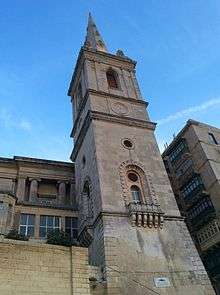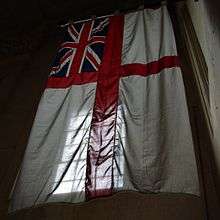St Paul's Pro-Cathedral
| St Paul's Pro-Cathedral | |
|---|---|
| The Pro-Cathedral and Collegiate Parish church of Saint Paul | |
| Il-Pro-Katidral ta' San Pawl | |
|
St Paul's Pro-Cathedral, Valletta | |
| 35°54′1.2″N 14°30′41.5″E / 35.900333°N 14.511528°E | |
| Location | Valletta |
| Country |
|
| Denomination | Church of England |
| Website | www.anglicanmalta.org |
| History | |
| Founded | 20 March 1839 |
| Founder(s) | Queen Adelaide |
| Dedication | Saint Paul |
| Architecture | |
| Status | Pro-cathedral |
| Functional status | Active |
| Architect(s) | Richard Lankesheer (later adjustments by William Scamp)[1] |
| Style | Neo-classical |
| Groundbreaking | 1839 |
| Completed | 1844 |
| Specifications | |
| Spire height | 200 ft (61 m)[2] |
| Administration | |
| Archdeaconry | Italy and Malta |
| Diocese | Diocese of Gibraltar in Europe |
| Province | Canterbury |
| Clergy | |
| Bishop(s) | Robert Innes |
| Chancellor | Simon Godfrey |
| Chaplain(s) | Clem Upton |
| Archdeacon | Vickie Sims |
| Laity | |
| Organist(s) |
Hugo Agius Muscat Philip Galea |
| Churchwarden(s) |
Clive Bennington Bernice Caruana |
St Paul's Pro-Cathedral (Malti: Il-Pro katridral ta San Pawl) is an Anglican pro-cathedral situated in Independence Square, Valletta, Malta. A "pro-cathedral", is a church with cathedral status, and is one of three cathedrals of the Anglican Diocese of Gibraltar in Europe.
Origin and construction
The cathedral was commissioned by the Dowager Queen Adelaide during a visit to Malta in the 19th Century when she found out that there was no place of Anglican worship on the island. Prior to this Anglican services were held in a room in the Grand Master’s Palace. Built on the site of the Auberge d'Allemagne (the conventual home of the German Knights Hospitaller), the cathedral was designed by William Scamp and was built between 1839 and 1844. Queen Adelaide laid the foundation stone on 20 March 1839 and her banner hangs above the choir stalls. The original plans were designed by Richard Lankasheer however the building proved unstable thus work had to resume on plans by Scamp in 1841. Scamp's designs located the altar on the west side of the church however the Bishop of Gibraltar had a more conservative view, thus the designs were altered and Scump designed an apse inside the great doors to hold the sanctuary on the east side. [3]


War period and repairs
During the war the cathedral was damaged and the roof collapsed however it escaped serious damage. During restoration works the original designs by Scump started to take shape. A quire and rood screen were built on the west side of the cathedral. A pulpit was also incorporated with the screen dedicated to Sir Winston Churchill. The new chancery was dedicated by the Archbishop of Canterbury Geoffrey Fisher on December 2nd, 1949 in the presence of Princess Elizabeth. The east side of the cathedral was then transformed into a baptistery. The under-croft, constructed from remains of the basement of the Auberge d'Allemagne was never used. In 1928 the Bishop of Gibraltar Nugent Hicks opened the under-croft as the new parish hall. In 1938 it was transformed as a gas proof air raid shelter and in the early days of the conflict was used by the chaplain, his wife and scores of Maltese citizens. In 2005 it was restored and upgraded.[4]
Interior
A Valletta landmark due to its spire rising over 60 metres,[5] it is constructed with Maltese limestone in a neo-classical style. The cathedral has columns with capitals of the Corinthian order while the capitals of the six columns of the portico are of the Ionic order.[6][7] The internal dimensions of the building are 33.5 metres x 20.4 metres. Behind the main altar is a painting titled Ecce Homo, the work of A E Chalon, donated in 2014. The Blessed Sacrament is reserved in the Lady chapel located to the left of the pulpit facing the altar.
Steeple
The cathedral's steeple is a landmark on its own being notably visible in the Marsamxett Harbour.[8] The church building is listed on the National Inventory of the Cultural Property of the Maltese Islands.[9]

Organ
Above the entrance to the cathedral is located the organ that originated in Chester Cathedral in northwest England. The one-manual instrument was built in 1684 by Bernard Smith and is said to have been played by George Frederick Handel while en route to Dublin for the first performance of the Messiah.
Association with British military forces
The oak panels around the High Altar are a memorial to the Allied units which took part in the defence of Malta between 1940 and 1943 and twelve flags hang in the aisles representing amongst others the Royal Air Force, the British Merchant Navy, and the Royal Navy.
See also
References
- ↑ https://www.mepa.org.mt/file.aspx?f=2033
- ↑ https://www.mepa.org.mt/file.aspx?f=2033
- ↑ id=Fevix8jSqg0C&pg=PA113&lpg=PA113&dq=grandmaster+perellos+fountain&source=bl&ots=TgtYK1oELZ&sig=g7x2oRANsxjMsSUh-cr7P_Lkij8&hl=en&sa=X&ved=0ahUKEwiLzYiXnsrMAhWDvhQKHe6EDKkQ6AEILTAI#v=onepage&q=grandmaster%20perellos%20fountain&f=false "Malta, Gozo and Comino". p. 119-120.
- ↑ "ST PAUL’S PRO-CATHEDRAL VALLETTA", Anglican Church in Malta. Retrieved on 03 December 2016.
- ↑ https://www.mepa.org.mt/file.aspx?f=2033
- ↑ https://www.mepa.org.mt/file.aspx?f=2033
- ↑ Valletta – vibrant city of many styles
- ↑ http://www.timesofmalta.com/articles/view/20150104/business-news/Valletta-vibrant-city-of-many-styles.550626
- ↑ "St. Paul's Anglican Cathedral" (PDF). National Inventory of the Cultural Property of the Maltese Islands. 27 August 2012. Retrieved 31 October 2015.

